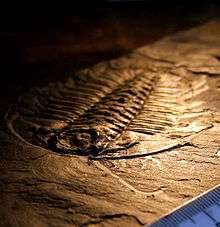Olenoides
| Olenoides Temporal range: upper Middle to lower Upper Cambrian | |
|---|---|
| | |
| Olenoides superbus from the Upper Marjum Formation | |
| Scientific classification | |
| Kingdom: | Animalia |
| Phylum: | Arthropoda |
| Class: | Trilobita |
| Order: | Corynexochida |
| Family: | Dorypygidae |
| Genus: | Olenoides Meek, 1877 |
| Species | |
Olenoides was a trilobite from the Cambrian period. Its fossils are found well-preserved in the Burgess Shale in Canada. It grew up to 10 cm long.
Olenoides followed the basic structure of all trilobites — a cephalon (head shield), a thorax with seven jointed parts, and finally a semicircular pygidium. Its antennae were long, and curved back along its sides. Its thin legs show that it was no swimmer, instead crawling along the sea floor in search of prey. This is also evidenced by fossil tracks that have been found. Conspicuous W-shaped wounds, often partially healed, on Olenoides specimens may be due to predation by Anomalocaris.[2]
Its major characteristics are a large parallel-sided glabella, deep interpleural furrows on the pygidium, and slender pygidial spines, as well as the fact that it is the most common limb-bearing trilobite species in the Burgess Shale.
Specimens have been found in the Marjumian of the United States (Utah and New York). General Cambrian fossils have been found in Canada (British Columbia and Newfoundland), Greenland, Kazakhstan, Russia, and the USA (Idaho, Nevada for which O. nevadensis is named, New York, Pennsylvania for which O. pennsylvanicus is named, Virginia, Utah, and Wyoming).[3]
213 specimens of Olenoides are known from the Greater Phyllopod bed, where they comprise 0.4% of the community.[4] The Burgess Shale's preservative qualities have helped Olenoides become one of the best known of trilobites.
Synonyms

Olenoides was formerly known as Neolenus. Kootenia is sometimes considered a junior synonym because the main morphological difference between the two genera was Kootenias lack of Olenoides strong interpleural furrows on the pygidium, which is now believed to be variable.[5]
Species
- O. nevadensis
- O. serratus
- O. buttsi (unrecognized)
- O. convexus (unrecognized)
- O. incertus (unrecognized)
- O. pennsylvanicus (unrecognized)
Description
Olenoides is an average size trilobite (up to 9 cm long), broadly oval in outline. Its headshield (or cephalon) is semi-circular. The central raised area of the cephalon (or glabella) is parallel-sided, rounded at its front and almost reaches the anterior border. Thin eye ridges swing back from the front of the glabella to the small, outwardly-bowed eyes. The free cheeks (or librigenae) narrow back into straight, slender genal spines that reach as far back as the third thorax segment. The articulating middle part of the skeleton (or thorax) consists of seven segments that end in needle-like spines. The semi-circular tail-piece (or pygidium) has six axial rings that decrease in size backwards and four or five pairs of rearward pointing marginal spines. The cephalon, thorax and pygidium are of approximately equal length.[1]
Olenellus serratus is one of about twenty species of which the non-calcified parts are known, due to so-called soft tissue preservation. The antennas are the most anterior pair of appendages in trilobites. In O. serratus, these are attached about halfway the immediately adjacent hypostome, and appear from the dorsal side under the cephalon in front of the side of the glabella. They appear to be flexible, have a tubular shape that become narrower when approaching their tips and consist of between 40 and 50 segments that are each shorter than wide. Olenellus serratus is the only known trilobite with cerci, uniramous appendages on ventral side of last pygidial segment, and these are shaped like the antennas.[6]
External links
- "Olenoides serratus". Burgess Shale Fossil Gallery. Virtual Museum of Canada. 2011.
References
- 1 2 team. "Olenoides serratus - The best-known trilobite from the Burgess Shale". The Burgess Shale. Royal Ontario Museum.
- ↑ Coppold, Murray and Wayne Powell (2006). A Geoscience Guide to the Burgess Shale, p.60. The Burgess Shale Geoscience Foundation, Field, British Columbia. ISBN 0-9780132-0-4.
- ↑ Paleobiology Database. "Chancia", accessed March 27, 2011
- ↑ Caron, Jean-Bernard; Jackson, Donald A. (October 2006). "Taphonomy of the Greater Phyllopod Bed community, Burgess Shale". PALAIOS. 21 (5): 451–65. doi:10.2110/palo.2003.P05-070R. JSTOR 20173022.
- ↑ Coppold, Murray and Wayne Powell (2006). A Geoscience Guide to the Burgess Shale, p.59. The Burgess Shale Geoscience Foundation, Field, British Columbia. ISBN 0-9780132-0-4.
- ↑ Moore, R.C. (1959). Arthropoda I - Arthropoda General Features, Proarthropoda, Euarthropoda General Features, Trilobitomorpha. Treatise on Invertebrate Paleontology. Part O. Boulder, Colorado/Lawrence, Kansas: Geological Society of America/University of Kansas Press. pp. 1–560. ISBN 0-8137-3015-5.
- Olenoides on the Smithsonian institution website
- A fossil photograph of Olenoides nevadensis This trilobite fossil is about 50 mm. long. It was found in the Marjum Formation in Utah. [Note - 25.4 mm=1 inch.]